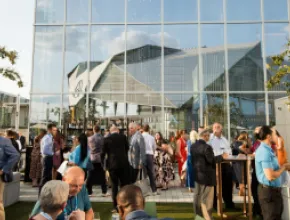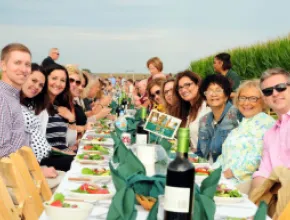Groups looking to soak up some of the most breathtaking sites on Earth, along with some of the best skiing, look to Utah. Yet while the state’s outdoor adventures continue to amaze, its heritage and culture are unlike anywhere else.
“The beauty alone is reason enough to come to Utah. The state’s unique history and culture enhance everything else,” says Chris Peterson, convention sales director at the Salt Lake CVB.
Utah’s rich and varied heritage includes Mormon pioneers, mountain men, Old West legends, a popular film festival and Native American culture.
Meanwhile, the state loosened a number of liquor laws in hopes that more visitors will come to Utah and boost its $6 billion tourism industry.
Salt Lake City
For groups looking to get to the roots of the history of Salt Lake City, Utah’s capital and most populous city, a visit to Temple Square is in order. As of 2006, the 10-acre complex was still the most popular tourist attraction in the state, topping the attendance at Utah’s renowned national parks— Zion, Bryce Canyon, Capitol Reef, Canyonlands and Arches.
“You can’t talk about our state’s heritage and culture without including Temple Square,” Peterson says.
He notes that attendees appreciate not only the history they absorb here (or the fact that a visit to the square is free), but also the accessibility and convenience. Three city blocks in downtown Salt Lake contain nearly 20 attractions related to Mormon pioneer history and genealogy. A suggested walking tour and a downloadable map of the sites are available at the state’s tourism website. Maps of the downtown area are available at the Salt Lake CVB’s website.
Temple Square contains the Salt Lake Temple, Salt Lake Tabernacle, Salt Lake Assembly Hall, Seagull Monument and two visitors’ centers. The neo-Gothic-style temple is the centerpiece of the square. The structure is not open to the public, but the temple’s serene grounds are. At the square’s South Visitors Center, groups can view photographs of the temple interior and check out the history of the temple in an exhibit that outlines how Mormon Church president and Salt Lake City founder Brigham Young selected the building site and how the temple was built over a 40-year period.
The North Visitors Center takes groups not only through facets of the Mormon faith, but also highlights of Christianity, including a replica of Jerusalem in New Testament times.
The Salt Lake Tabernacle, home of the Mormon Tabernacle Choir, is a popular attraction in the square. The 11,623-pipe Tabernacle Organ and the astonishing acoustics (you can really hear a pin drop here) are highlights of tours, which usually occur daily.
Visitors can hear the choir for free twice a week, Peterson notes, for a Thursday night rehearsal and a Sunday morning radio broadcast.
“This continues to be one of the most popular things groups do when they convene in Salt Lake,” Peterson says.
The square also contains the Family History Library, the world’s largest genealogical library. The facility is open to the public at no charge. Peterson says groups can easily spend the whole day here researching family origins.
More than Mormon heritage is found in Salt Lake City. The Marmalade Historic District was named for the fruit trees planted by the area’s early residents. While visitors won’t find an orchard today, they will enjoy strolling down streets named Apricot and Quince, marveling at historic structures such as some of the city’s oldest adobe homes and the onion dome of the 19th Ward Chapel. The Utah Heritage Foundation offers tours, which are available for groups of between 10 and 20 people.
“Many DMCs can put together great tours that highlight Salt Lake’s unique history,” Peterson says.
History buffs should make a stop at This Is the Place Heritage Park, located on the site where Brigham Young and his party first entered the Utah Valley in 1847. Meetings and other events can be held at a number of facilities at the park. The Bowery structure, an alfresco space for groups at the park, features a thatched roof and a stage.
Much of the history of Utah was carved out by those who came to mine for the state’s abundant minerals. The Bingham Canyon Open Pit Copper Mine, producing 150,000 tons of copper ore daily, is located 28 miles southwest of Salt Lake and is the planet’s largest man-made excavation. Groups can tour the massive open pit that can be seen from shuttles in outer space.
Groups can explore more modern times at the Olympic Cauldron Park, the site of the opening and closing ceremonies of the 2002 Winter Olympics. The park’s visitors center is a unique space available for private rental.
Park City
Nestled in the Wasatch Mountains, about 45 minutes to the east of Salt Lake, Park City is renowned for its outdoor pursuits, most notably skiing. But the area is the center of much history and culture, both byproducts of its natural environment.
“Park City is a beautiful resort town, but we started as a mining community,” notes Deborah Lewis, visitors services manager for the Park City Chamber of Commerce and Visitors Bureau. “The town still has that picturesque look of an old mining town.”
Park City’s Main Street features several Victorian buildings that are on the National Register of Historic Places, and its arts and cultural scene is thriving with everything from galleries where planners can arrange private receptions to Robert Redford’s annual Sundance Film Festival. Local DMCs can arrange for groups to attend screenings and other events during the festival, while planners can utilize the historic Egyptian Theatre, an icon of Sundance, for private get-togethers.
Park City is celebrating its 125th anniversary this year. Along with that milestone, the Park City Museum is slated to open this October after being closed during a two-year, $8.9 million renovation. The museum will feature an additional 5,000 square feet of exhibition space and an expanded history library. Highlights of the new exhibits will include a mine drill that visitors can operate.
The Park City Historical Society offers historical hiking tours of the area every summer with research historian Hal Compton. The society also coordinates a historic home tour. Each year, local residents open the doors of their historic homes to groups. Tours are followed by a party with gourmet food and wine.
A top attraction that underscores the importance of Park City’s skiing heritage is Utah Olympic Park. The facility served as the 2002 Winter Olympics venue for ski jumping, bobsled, luge and other competitions. Groups can often witness national and international competitions and Olympic athletes training, or get in on the action with 70-mile-an-hour bobsled rides.
“We are talking pulling some serious g-forces,” Peterson says.
A number of sites at the facility are available for groups. The Alf Engen Ski Museum is a unique spot for receptions of up to 144 people.
The Olympic stamp is found even in accommodations at the Stein Eriksen Lodge, named after the Norwegian Olympic gold medalist.
Utah Valley
Utah Valley is located in North Central Utah, 42 miles from Park City and 35 miles from Salt Lake City International Airport. It encompasses the cities of Provo, Orem and their suburbs, including Spanish Fork and American Fork. The area is a great place for groups interested in Native American culture and pioneer lore.
Brigham Young University’s Museum of People and Cultures draws groups in Provo. The Provo Marriott Hotel & Conference Center is nearby. The Crandall Historic Printing Museum, also in Provo, features replicas of historic shops and printing presses, including an original page of the Gutenberg Bible. Groups can tour 22 pioneer buildings in Provo, dating back to as early as 1849.
At the John Hutching Museum of Natural History in Lehi, groups can learn about Utah’s pre-historic inhabitants, the Anasazi and the Fremont-Sevier people, along with Native Americans that lived in the state, the Paiutes, Goshutes and Shoshones.
Camp Floyd/Stage Coach Inn State Park and Museum in Fairfield is a popular place for groups, says Charlene Christensen, director of services for the Utah Valley CVB.
“The camp was created in 1858 when the U.S. government imagined a Mormon rebellion in Utah that never happened,” Christensen notes.
About one-third of the entire U.S. Army at that time, 3,500 troops, set up camp to monitor the situation and explore the Western frontier. Some of the troops went prospecting when they got bored.
There are a number of activities for groups at Camp Floyd, Christensen says.
Northern Utah
Like most of Utah, Ogden provides groups with unique historic sites amid scenic beauty. The Ogden/Weber area is located at the base of Ben Lomond Peak, Strawberry Peak and Mount Ogden.
Ogden was known as a major passenger railroad junction in the late 1800s. Union Station is no longer a railway hub, but it’s still the heart of the city. The Utah State Railroad Museum and three other museums are housed in the station, according to Rich Koki, director of sales for the Ogden CVB. A number of spaces are available at the facility for groups, including the M.S. Browning Theater, which can accommodate up to 350 for a dinner.
For groups looking for culture in a small-town setting, the Cache Valley offers the Utah Festival Opera, Ellen Eccles Theatre and Utah State University’s Performing Arts Series. Logan features more mountain scenery, along with cultural lures such as the Jensen Historical Farm at the American West Heritage Center.
Southern Utah
Not only is the St. George area located near Zion and Bryce Canyon national parks, the north rim of the Grand Canyon and Lake Powell, but it’s also the site of charming 19th century homes and old dirt roads that lead to prehistoric dinosaur footprints and eerie ghost towns.
Grafton is an old ghost town that served as the backdrop for the movie Butch Cassidy and the Sundance Kid.
In the Cedar City-Brian Head area, groups can check out the Parowan Gap Petroglyphs, rock carvings likely produced by the Fremont civilization. Tours are available of the carvings and other historic sites in the area, says Maria Twitchell, executive director of the Cedar City-Brian Head Tourism Bureau.
In addition to pioneer houses that double as group venues, the area boasts the Tony Award-winning Utah Shakespearean Festival.
“There’s a mix of Shakespeare plays and more contemporary plays,” Twitchell notes. “The venue is on par with the Shakespeare festivals in Ashland, Ore., and Stratford, Ontario, with some serious actors.”
Farther east, Moab features remarkable Native American rock art. Some are easy to find, while some require a bit more digging. Seeking out the impressive petroglyphs is well worth the effort. The Moab Visitors Center offers a detailed map to the area’s rock art sites.
Groups can also tour the many movie sites in Moab, where scores of classic Westerns and modern movies were filmed, including Thelma and Louise and the John Wayne-John Ford epic Rio Grande.
For More Info
Cache Valley Visitors Bureau 435.755.1890 www.tourcachevalley.com
Cedar City-Brian Head Tourism Bureau 435.586.5124 www.scenicsouthernutah.com
Davis Area CVB 801.774.8200 www.davisareacvb.com
Moab Area Travel Council 435.259.1370 www.discovermoab.com
Ogden/Weber CVB 801.778.6250 www.ogden.travel
Park City COC and CVB 435.649.6100 www.parkcitymeetings.com
Salt Lake CVB 801.534.4900 www.visitsaltlake.com
St. George Area CVB 435.634.5747 www.utahstgeorge.com
Utah Office of Tourism 801.538.1030 www.utah.com
Utah Valley CVB 801.851.2100 www.utahvalley.org






